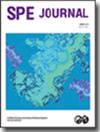A Real-Time Inversion Approach for Fluid-Flow Fractures in Unconventional Stimulated Reservoirs
IF 3.2
3区 工程技术
Q1 ENGINEERING, PETROLEUM
引用次数: 0
Abstract
Summary Fluid-flow fractures, through which fluids can move under pressure, make a more significant contribution to increasing production than do microseismic and propagation fractures. An accurate description of the distribution of fluid-flow fractures is the basis for evaluating hydraulic fracturing and oil/gas recovery. In this study, a real-time inversion approach for fluid-flow fractures was proposed, and the complex fluid-flow fracture morphology was obtained in real time by updating the data of the fracturing construction curve. First, a dynamic permeability model was proposed to describe the filtration rate of the fracturing fluid during hydraulic fracturing. Combined with the point source function, the flowing bottomhole pressure (pwf) can be quickly calculated based on the fracture morphology and displacement of the fracturing fluid. The variance of pwf and bottomhole pressure (pwb) obtained by pump pressure were used as an objective function, and the length of fluid-flow fractures and fracture morphology were used as fitting parameters. The length of the fluid-flow fractures was updated with the simultaneous perturbation stochastic approximation (SPSA) to achieve a rough fitting of the bottomhole pressure. On this basis, a probability function was used to constrain the randomness of the fractures, and the fracture morphology with a fixed fracture length was continuously simulated and finely matched. Finally, a complex fluid-flow fracture morphology was obtained. The method was used to analyze the fluid-flow fracture morphology of multifractured horizontal wells in shale reservoirs, and the fitting rate of the fracturing construction curve was more than 95%. The results show that the total length of the fluid-flow fractures in one stage in naturally fractured reservoirs was approximately 629 m, and those in homogeneous reservoirs and high-stress difference reservoirs were 564 m and 532 m, respectively. The length of fluid-flow fractures with “grooves” in the fracturing construction curve was longer than the length of fluid-flow fractures with “bulges.” The effectively stimulated reservoir area with fluid-flow fractures was only approximately 28–51% of the stimulated reservoir area with microseismic fractures.非常规油藏流体流动裂缝实时反演方法
流体流动裂缝是流体在压力下流动的裂缝,与微地震裂缝和扩展裂缝相比,流体流动裂缝对增产的贡献更大。准确描述流体裂缝的分布是评价水力压裂和油气采收率的基础。本研究提出了一种流体-流动裂缝实时反演方法,通过更新压裂施工曲线数据,实时获得复杂的流体-流动裂缝形态。首先,建立了描述水力压裂过程中压裂液过滤速率的动态渗透率模型。结合点源函数,可以根据压裂液的裂缝形态和排量,快速计算出井底流动压力(pwf)。以泵压力得到的pwf和井底压力(pwb)的方差作为目标函数,以流体流动裂缝长度和裂缝形态作为拟合参数。利用同步摄动随机近似(SPSA)更新流体裂缝长度,实现井底压力的粗略拟合。在此基础上,利用概率函数约束裂缝的随机性,对固定断裂长度的裂缝形态进行连续模拟和精细匹配。最后,得到了复杂的流体流动裂缝形态。将该方法应用于页岩储层多缝水平井流体流动裂缝形态分析,压裂施工曲线拟合率达95%以上。结果表明:天然裂缝性储层一期流体流动裂缝总长度约为629 m,均质储层一期流体流动裂缝总长度为564 m,高应力差储层一期流体流动裂缝总长度为532 m。裂缝施工曲线上具有“凹槽”的流体裂缝长度大于具有“凸起”的流体裂缝长度。含流体裂缝的有效改造面积仅为微地震裂缝改造面积的28-51%左右。
本文章由计算机程序翻译,如有差异,请以英文原文为准。
求助全文
约1分钟内获得全文
求助全文
来源期刊

SPE Journal
工程技术-工程:石油
CiteScore
7.20
自引率
11.10%
发文量
229
审稿时长
4.5 months
期刊介绍:
Covers theories and emerging concepts spanning all aspects of engineering for oil and gas exploration and production, including reservoir characterization, multiphase flow, drilling dynamics, well architecture, gas well deliverability, numerical simulation, enhanced oil recovery, CO2 sequestration, and benchmarking and performance indicators.
 求助内容:
求助内容: 应助结果提醒方式:
应助结果提醒方式:


